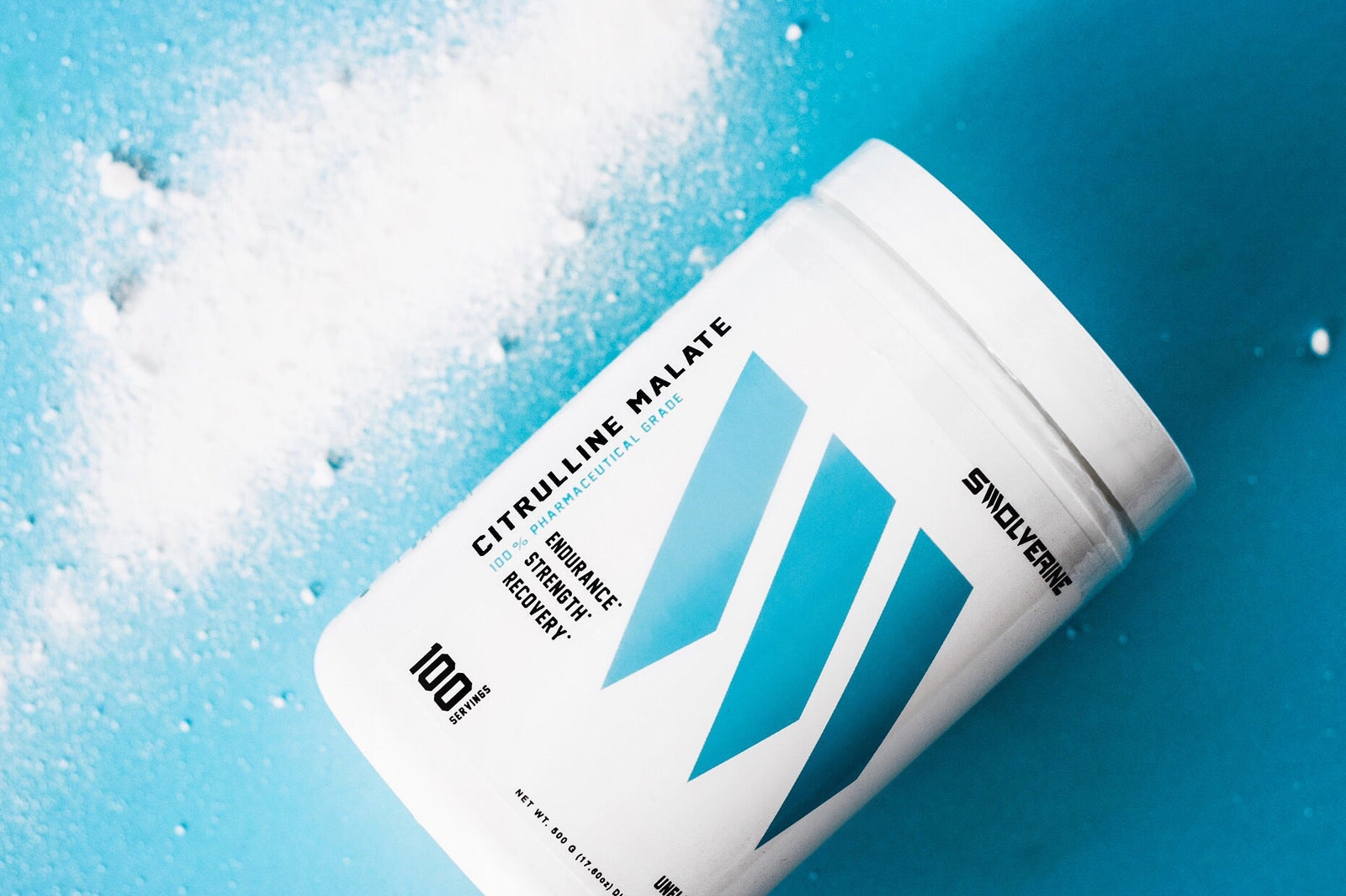Both L-Citrulline and Citrulline Malate promote the natural production of nitric oxide (NO) in the body, which enhances blood flow, nutrient delivery, and exercise performance. Though they sound similar, there are key differences between these two ingredients—especially when it comes to building muscle, increasing strength, and improving endurance.
If you’re serious about optimizing your training, it’s worth understanding how these supplements differ. Let’s break down the science behind Citrulline Malate vs. L-Citrulline, and which one delivers superior results in the gym.
What Is Citrulline Malate?
A Combination of Citrulline and Malic Acid
Citrulline Malate is a compound made up of L-Citrulline (a non-essential amino acid) and malate, which is derived from malic acid, a compound naturally found in apples. L-Citrulline is commonly extracted from watermelon, and the compound has been used in Europe for over two decades as a pharmacological treatment for fatigue, muscle weakness, and even dementia.
More recently, it has gained popularity in sports performance for its ability to enhance energy production and delay fatigue.
How Does Citrulline Malate Work?
Nitric Oxide, ATP, and Energy Efficiency
L-Citrulline plays a key role in the urea cycle, helping detoxify ammonia—a byproduct of protein metabolism during exercise. Once ingested, Citrulline Malate is converted into arginine and ornithine, which in turn boosts nitric oxide (NO) production. Nitric oxide acts as a vasodilator, widening blood vessels to enhance blood flow, oxygen delivery, and nutrient transport to muscles.
Malate, on the other hand, supports the tricarboxylic acid (TCA) cycle, boosting aerobic ATP production—the energy system used during endurance and resistance training (Sureda et al., Free Radical Research).
Benefits of Citrulline Malate
1. Reduces Muscle Fatigue and Boosts Endurance
A study published in the British Journal of Sports Medicine found that 6 grams of Citrulline Malate daily increased the rate of oxidative ATP production by 34%, and improved phosphocreatine recovery by 20% following exercise (Bendahan et al., BJSM). This indicates more efficient energy utilization and better endurance during high-intensity workouts.
2. Improves Recovery and Reduces Soreness
Research from the Journal of Strength and Conditioning Research showed that participants who took Citrulline Malate were able to perform 52.92% more repetitions during resistance training compared to placebo. Additionally, muscle soreness was reduced by 40% at both 24 and 48 hours post-exercise (Perez-Guisado et al., JSCR).
3. Supports Muscle Growth and Amino Acid Utilization
Citrulline Malate enhances protein synthesis, allowing for better absorption of amino acids—especially branched-chain amino acids (BCAAs)—which are critical for muscle repair and hypertrophy. It also elevates insulin levels, supporting anabolic activity and lean muscle development.
Related Article: How Citrulline Malate Improves Athletic Performance
What Is L-Citrulline?
The Free-Form Amino Acid Behind NO Boosting
L-Citrulline is a non-essential amino acid that converts into L-arginine in the kidneys, facilitating nitric oxide production. It’s commonly used in pre-workout supplements for its ability to increase vascularity, muscle pumps, and endurance.
Unlike Citrulline Malate, L-Citrulline does not contain malate and therefore lacks the added benefit of boosting ATP production through the TCA cycle.
Citrulline Malate vs L-Citrulline
Which Delivers Better Performance Benefits?
Recent studies have drawn comparisons between the two forms of citrulline—specifically looking at performance outcomes related to strength, power, and muscular endurance.
While Citrulline Malate consistently demonstrates performance-enhancing effects, L-Citrulline alone has shown mixed and often inconclusive results. One key difference is that L-Citrulline doesn’t contribute to aerobic ATP production the way Citrulline Malate does, because it lacks malate—an intermediate in the TCA cycle (Gowda et al., Metabolites).
Systematic Review Findings
A systematic review published in Sports Medicine examined 12 studies with 198 participants, evaluating L-Citrulline’s impact on strength and power. The review concluded that L-Citrulline supplementation had no significant effect on strength or power in most populations. However, it did suggest that elite athletes—where competition is determined by very small performance margins—might benefit from it in specific scenarios (Trexler et al., Sports Medicine).
New Research on Citrulline Malate and L-Citrulline
Recent Insights on Effectiveness and Limitations
A 2021 critical review revisited the proposed ergogenic mechanisms of Citrulline Malate. While malate was thought to contribute to increased ATP production through the TCA cycle, the review emphasized that these pathways have not yet been verified in human models and that more research is needed (Gonzalez and Trexler, Nutrients).
In 2023, a randomized controlled study evaluated the impact of L-Citrulline supplementation on endurance performance in young adults. The study found no significant improvements in endurance outcomes, casting doubt on the standalone effectiveness of L-Citrulline for aerobic performance (Sim et al., Journal of Dietary Supplements).
Another study published in Sports in 2023 tested the effects of 8 grams of L-Citrulline on resistance exercise performance. Results showed no significant improvements in muscle endurance, isometric strength, or oxygen saturation in muscle tissue (Kraemer et al., Sports).
The Bottom Line: Citrulline Malate Wins for Performance
If you’re looking for performance-enhancing benefits such as increased stamina, faster recovery, greater strength, and improved blood flow, Citrulline Malate is the superior choice. The inclusion of malate enhances ATP production, supports endurance, and amplifies the effects of nitric oxide far more efficiently than L-Citrulline alone.
While L-Citrulline still holds value—especially in pump-focused pre-workouts—Citrulline Malate offers a more comprehensive performance edge backed by stronger clinical research.
Citrulline Malate vs. L-Citrulline: Takeaway
In the end, if you’re deciding between L-Citrulline and Citrulline Malate, evidence suggests that Citrulline Malate improves performance measures better than L-Citrulline alone. Studies show that L-citrulline does not directly affect aerobic ATP production. Malate which is an intermediate of the tricarboxylic acid cycle (TCA) or urea cycle affects aerobic ATP production through anaplerotic reactions. ATP is the body’s natural energy source, and without generating ATP, you lose performance benefits such enhancements in endurance, and power output.







